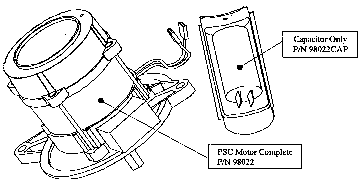We are pleased to introduce the Carlin Permanent Split Capacitor (PSC) Motor. This motor is NOW the standard motor on burner models EZ1, EZ2, EZ3, 99FRD, 100CR]) and 1O2CRD Carlin Burners. There are several differences between the standard split phase burner motors and the permanent split capacitor motor. Some of these differences involve the motor construction and some involve operational and performance differences. It is VERY IMPORTANT for the INSTALLING TECHNICIAN to familiarize himself or herself with these differences.
MOTOR CONSTRUCTION DIFFERENCES:
- The Carlin PSC Motor utilizes a capacitor to assist start-up and run of the motor. This eliminates the need for a start switch used in the split phase motor. The Carlin motor capacitor is field replaceable for ease of service.
- The Carlin PSC Motor has ball bearings not sleeve bearings. The ball bearings are sealed and require no oiling. Ball bearing design eliminates much of the end play standard motor shafts exhibit and allow for more consistent air flow to the combustion head.
- The Carlin PSC Motor features an AUTOMATIC thermal overload protection system. This feature will help eliminate nuisance service calls caused by failure of the manual overload reset switch, as well as, compensate for overloads caused by temporary voltage fluctuations. This automatic reset system is significantly more tolerant of overload than the traditional manual reset configurations.
- The motor capacitor is located at the 9:00 (9 o’clock) position making for convenient mounting to any burner with or without an electrical box over the motor.
- Electrical leads are long enough for easy installation on any manufacturer’s burner.
- Backwards compatible with any 48M frame 3450 burner motor 1/7HP or 1/6HP.
OPERATIONAL PERFORMANCE DIFFERENCES:
- The superior design and construction of the Carlin PSC motor allows for more consistent air flow to the combustion head of the burner.
- As with any component change on a burner, when installing the Carlin PSC motor you SHOULD EXPECT OPERATIONAL CHANGES to the burner. The INSTALLING TECHNICIAN MUST PERFORM A COMBUSTION EFFICIENCY TEST to determine how the airflow to the burner was effected by the installation of the PSC motor. Typically the technician will notice an increase in the airflow delivered by the PSC motor over a standard split phase motor.
- The Carlin PSC motor uses less than 1/2 the starting amps and has significantly lower running amps.
- You will notice a significant reduction in mechanical noise emission from the Carlin PSC motor when compared to a standard split phase motor.
TROUBLESHOOTING THE CARLIN PSC MOTOR CAPACITOR:
If the capacitor portion of the Carlin PSC Motor should fail, it IS replaceable.
To check the operation of the capacitor follow this procedure:
- Disconnect electrical power to the burner.
- Using electrical pliers carefully remove the two wires one at a time from the capacitor.
- You must be sure that the capacitor is not storing a charge. CAREFULLY, USING A SCREWDRIVER WITH A WELL-INSULATED HANDLE, place the screwdriver blade across the two capacitor terminals. This will insure that the capacitor discharges any stored current.CAUTION: UNDER CERTAIN CONDITIONS THE CAPACITOR CAN STORE ELECTRICAL CHARGE, CREATING A HAZARD TO THE SERVICE TECHNICIAN. HANDLE CAPACITOR CAREFULLY!
- Using an Ohm Meter (an analog meter is preferred, due to the fact that some digital meters will not respond rapidly enough to the change in resistance) place one lead from the meter to each of the capacitor terminals. The meter should go to a non-infinite reading immediately and then rapidly increase to an infinity reading. This will happen in approximately one second. If the meter stays on a non-infinite reading the capacitor has an open circuit and must be replaced. If the meter reads a constant zero ohm reading, the capacitor has a short circuit and must be replaced.
The Carlin Part Number for our replacement motor capacity is
P/N 98022CAP.

*THE CARLIN PSC MOTOR CARRIES A FULL THREE YEAR WARRANTY!
Technical Hot Line 800-989-2275
www.carlincombustion.com

Leave A Comment